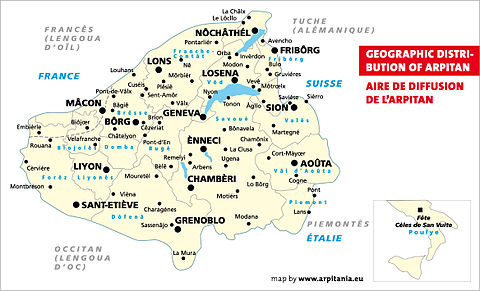Arpitania


Arpitania(Arpitan and Italian:Arpitania,French:Arpitanie) is a term which denotes the purported ethnic or cultural unity of theWestern Alps,represented by speakers ofFranco-Provençal(termedArpitan).
"Arpitania" roughly corresponds to the historicalCounty of Savoyand its successor state theDuchy of Savoy:
- France(Ain,Rhône,Savoie,Haute-Savoie,a big part of theI sắc redepartment,southernFranche-Comté). The northwestern salient (roughly a strip betweenMâconandRoanne) is seen linguistically transitional between Arpitan,Occitan,and otherOïl languages.[citation needed]
- Italy(Aosta Valley,parts ofPiedmont,FaetoandCelle di San Vitoin theProvince of Foggia,inApulia)
- Switzerland(Romandy,excluding the northern and western parts ofJura)
Creation
[edit]The termsArpitanandArpitania(Arpitanie) are neologisms coined in the 1970s byJoseph Henriet(born 1945), a Communist school teacher who was influenced by the Basque activistFederico Krutwig.In hisGaraldea(published 1978), Krutwig names theBasques"Garalditans", a purportedNeolithicrace which he claimed existed thousands of years ago. Looking for racial or linguistic remnants of the "Garalditans", he moved to the Aosta Valley in 1970, constructing Basque etymologies for local placenames.
In Aosta, Krutwig befriended the youngMaoistactivist Joseph Henriet. Influenced by Krutwig, Henriet declared the local patois the descendant of the Neolithic "Garalditan language". He later replaced the termgaralditanwithharpitan,a conflation of the patois wordsarpa"alp",arpian"one who works on an alp", and the Basque etymology Basqueharri-pe"under the rocks" proposed by Krutwig.
Around 1980, Harriet dropped the Basque-inspired initialh-,now proposing an "Arpitan confederation" (Confédération arpitane) unitingSavoyand theValais(but not including the patois-speakingVaud). With the failure of his Arpitan political movement, he retired to private life.
The termarpitansince the 1990s has found usage beyond the immediate sphere of Henriet's activities, especially driven by online use. Pichard (2009) suggests its newfound success was due to the happy rhyme withOccitanand the unwieldiness of the alternativefrancoprovençal.The alternative termpatois,while viewed with affection in Switzerland, has a condescending or "humiliating" connotation in France. AnAliance Culturèla Arpitanawas founded in 2004.[2]
See also
[edit]References
[edit]- ^online use reported in 2014. Manuel Meune in:Ex(tra)territorial: Reassessing Territory in Literature, Culture and Languages / Les Territoires littéraires, culturels et linguistiques en question,Didier Lassalle, Dirk Weissmann (eds.), 2014,p. 278.
- ^Gianpaolo Charrere,Ayas, un film sul sogno dell'Harpitanya,Aoste: La Stampa, 15 february 2012 and"La nation arpitane". Alain Pichard,Nos ancêtres les ArpitansArchived2011-07-15 at theWayback Machine,24 Heures, Lausanne, 2 May 2009
Bibliography
[edit]- Jozé Harrieta [Joseph Henriet],La lingua arpitana,1976.
- Mikael Bodlore-Penlaez,«Savoy and Aosta, heart of the Arpitan people» inAtlas of Stateless Nations in Europe: Minority People in Search of Recognition,Y Lolfa, 2011.ISBN978-1-84771-379-7
- Les Alpes et leurs noms de lieux, 6000 ans d'histoire?: Les appellations d'origine pré-indo-européenne., Paul-Louis Rousset, 1988,ISBN2-901193-02-1
- Les mots de la montagne autour du Mont-Blanc, Hubert Bessat et Claudette Germi, Ed. Ellug, Programme Rhône-Alpes, Recherches en Sciences Humaines, 1991,ISBN2-902709-68-4.
External links
[edit]- Aliance Culturèla Arpitana
- Babel Lexilogos (French)
- Harpitanya Movement Flag
- Listen to some audio documentsArchived2014-07-16 at theWayback Machinein an Arpitan dialect.
